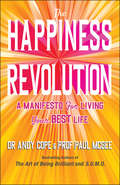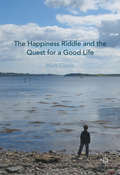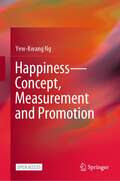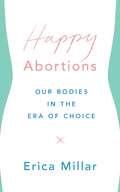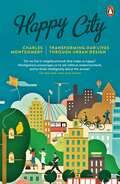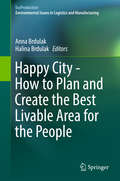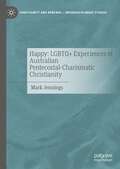- Table View
- List View
The Happiness Revolution: A Manifesto for Living Your Best Life
by Andy Cope Paul McGeeA new book by two of the biggest powerhouses in positive psychology and personal development – Dr Andy Cope and Professor Paul McGee Happiness. We chase it, we crave it…it’s so in demand… yet so scarce and fleeting. But here’s the good news. In The Happiness Revolution: A Manifesto For Living Your Best Life, bestselling authors Dr Andy Cope and Professor Paul McGee deliver a page-turning self-help book of the times, for the times. As the world wakes up to a new kind of normal, The Happiness Revolution challenges readers to sign up to an uprising of wellbeing and to making the most of the privilege of being on this planet. The book outlines a 10-point Happiness Manifesto. Grounded in the science of human flourishing and the reality of life, the principles are simple, do-able and above all make a difference not only to yourself but to others too. Let the fight back to mental wealth start right here. Welcome to global domination of the happiness kind! Discover: How to regain your sanity, clarity, and wellbeing, even when your smartphone, kids, spouse, job, and possessions seem to be conspiring to keep you from doing just that. Why it can be so hard to maintain a happy outlook when the outside world has never been so fast, complex, and unpredictable. How to be at your best in a world that is doing its worst. Happiness is the #1 thing you want for yourself and your family. The Happiness Revolution is an indispensable guide for everyone trying to live their best life and to spread some happiness whilst doing so. Rise Up and Be Happy! Vive la revolution!
The Happiness Riddle and the Quest for a Good Life
by Mark CieslikThis book examines the meaning of happiness in Britain today, and observes that although we face challenges such as austerity, climate change and disenchantment with politics, we continue to be interested in happiness and living well. The author illustrates how happiness is a far more contested, social process than is often portrayed by economists and psychologists, and takes issue with sociologists who often regard wellbeing and the happiness industry with suspicion, whilst neglecting one of the key features of being human – the quest for a good life. Exploring themes that question what it means to be happy and live a good life in Britain today, such as the challenges young people face making their way through education and into their first jobs; work life-balance; mid-life crises; and old age, the book presents nineteen life stories that call for a far more critical and ambitious approach to happiness research that marries the radicalism of sociology, with recent advances in psychology and economics. This book will appeal to students and academics interested in wellbeing, happiness and quality of life and also those researching areas such as the life course, work-life balance, biographies, aging and youth studies.
Happiness, Technology and Innovation (SpringerBriefs in Well-Being and Quality of Life Research)
by Gaël Brulé Francis MunierThis book asks what kind of impacts innovations and technology have on subjective well-being and happiness. It presents the state of the art both in terms of results and theoretical questioning on these topics. It proposes a new concept: innovation that leads to greater happiness, and highlights new research in this area. In so doing, it addresses a less researched area in the field of well-being research. The authors state that notwithstanding the indisputable positive contributions of innovation and technology, there are also drawbacks, which need equal attention in research. This book is of interest to students and researchers of quality of life and well-being, as well as innovation research.
Happiness—Concept, Measurement and Promotion
by Yew-Kwang NgThis open access book defines happiness intuitively and explores several common conceptual mistakes with regard to happiness. It then moves on to address topical issues including, but not limited to, whether money can buy you happiness, why happiness is ultimately the only thing of intrinsic value, and the various factors important for happiness. It also presents a more reliable and interpersonally comparable method for measuring happiness and discusses twelve factors, from A to L, that are crucial for individual happiness: attitude, balance, confidence, dignity, engagement, family/friends, gratitude, health, ideals, joyfulness, kindness and love. Further, it examines important public policy considerations, taking into account recent advances in economics, the environmental sciences, and happiness studies. Novel issues discussed include: an environmentally responsible happy nation index to supplement GDP, the East Asian happiness gap, a case for stimulating pleasure centres of the brain, and an argument for higher public spending.
Happy Abortions: Our Bodies in the Era of Choice
by Erica Millar'A provocative and important book that every pro-choice advocate should read.'Sinéad Kennedy, Coalition to Repeal the 8th AmendmentWhen it comes to abortion, today's liberal climate has produced a common sense that is both pro-choice and anti-abortion. The public are fed an unchanging version of what the abortion choice entails and how women experience it. While it would prove highly unpopular to insist that all pregnant women should carry their pregnancy to term, the idea that abortion could or should be a happy experience for women is virtually unspeakable.In this careful and intelligent work, Erica Millar shows how the emotions of abortion are constructed in sharp contrast to the emotional position occupied by motherhood – the unassailable placeholder for women's happiness. Through an exposition of the cultural and political forces that continue to influence the decisions women make about their pregnancies – forces that are synonymous with the rhetoric of choice – Millar argues for a radical reinterpretation of women's freedom.
Happy Abortions: Our Bodies in the Era of Choice
by Erica Millar'A provocative and important book that every pro-choice advocate should read.'Sinéad Kennedy, Coalition to Repeal the 8th AmendmentWhen it comes to abortion, today's liberal climate has produced a common sense that is both pro-choice and anti-abortion. The public are fed an unchanging version of what the abortion choice entails and how women experience it. While it would prove highly unpopular to insist that all pregnant women should carry their pregnancy to term, the idea that abortion could or should be a happy experience for women is virtually unspeakable.In this careful and intelligent work, Erica Millar shows how the emotions of abortion are constructed in sharp contrast to the emotional position occupied by motherhood – the unassailable placeholder for women's happiness. Through an exposition of the cultural and political forces that continue to influence the decisions women make about their pregnancies – forces that are synonymous with the rhetoric of choice – Millar argues for a radical reinterpretation of women's freedom.
Happy City: Transforming Our Lives Through Urban Design
by Charles MontgomeryHappy City is the story of how the solutions to this century's problems - from climate change to overpopulation - lie in unlocking the secrets to great city living This is going to be the century of the city. But what actually makes a good city? Why, really, are some cities a joy to live in? As writer and journalist Charles Montgomery reveals, it's not how much money your neighbours earn, or how spectacular the views from your windows are, or even how pleasant the climate is that makes the most difference. Journeying to dozens of cities - from Atlanta to Bogotá to Vancouver - he talks to the new champions of the happy city to discover the progressive movements already transforming people's lives. He meets the visionary Colombian mayor who turned some of the world's most dangerous roads into an urban cycling haven; the Danish architect who brought the lessons of medieval Tuscan towns to modern-day Copenhagen; the New York City transport commissioner who made out of the gridlock of Times Square a place where people could lounge in the sun; and the Californian mother with the super-commute who completely rethought her idea of the suburban dream for the sake of her son's health. These urban trailblazers, as well as the many other planners, engineers, grass-roots campaigners and ordinary citizens, offer a wealth of surprising lessons for the rest of us. From how saying hello to your neighbours is just as important to your sense of trust as contact with close friends and family, and how living close to parks makes us smarter, kinder and reduces local crime rates, to the importance of the 'magic triangle' rule, Happy City shows thatsimple changes can make all the difference.Charles Montgomery is a journalist and urban experimentalist from Vancouver, Canada. His writings on urban planning, psychology, culture, and history have appeared in magazines and journals on three continents. He is the author of two previous books, and is a member of the BMW Guggenheim Lab team.
Happy City - How to Plan and Create the Best Livable Area for the People (EcoProduction)
by Anna Brdulak Halina BrdulakThis book presents multi-sector practical cases based on the author’s own research. It also includes the best practice, which could serve as a benchmark for the creation of smart cities. The global urbanisation index, i.e., the ratio of city dwellers to the total population, has been steadily increasing in recent years. It is highest in the Americas, followed by Europe, Asia and Africa. The city of the future will combine the intelligent use of IT systems with the potential of institutions, companies and committed, creative inhabitants. The administrative boundaries of today’s cities put certain constraints on their further growth, but in the future these boundaries will no longer be as relevant. Cities in Europe face the challenge of reconciling sustainable urban development and competitiveness – a challenge that will likely influence issues of urban quality such as the economy, culture, social and environmental conditions, changing a given city’s profile as well as urban quality in terms of its composition and characteristics.
Happy Economics: Why the Happiest Workplaces are the Most Successful
by Mark PriceHappiness at work matters. But what does happiness mean? How can managers measure it and have more of it? And what happens to organizations when they get happiness right? Ask anyone. Happiness and wellbeing are important for all organizations, because they undeniably lead to economic happiness and financial success for everyone involved. But how does happiness drive growth and how should business leaders develop happier companies? In Happy Economics, business expert Mark Price clearly demonstrates why the opportunity represented by happiness is huge for businesses. Using real-world examples of those organizations who have got it right, he explains what happy economics is, why happiness metrics matter, connects high happiness with high performance, explores how to create happy teams and creating a corporate happiness plan that can be used by any business.
The Happy Index: Lessons in Upside-Down Management
by null James TimpsonDiscover the secrets of upside-down management and doing the right thing with James Timpson's The Happy Index. With over 2,000 locations across the UK and overseeing multiple operations daily for the past two decades, it’s fair to say that the CEO of the family-owned Timpson business knows a thing or two about running a successful company. What makes James Timpson’s approach to collaboration, profit and success is simple: let the people you hire run your business. That might seem like a simple concept to a CEO, manager or director but if you think about the hundreds of meetings, hours lost from your day by responding to emails, signing off on projects and more, you will notice that you are still working in a traditional, top-down mindset. Doing this means the team you work with only see themselves as a cog in the machine instead of the trusted, valued colleagues that they are. The Happy Index is structured into lessons that will equip you and the people you work with, with the tools and tactics to re-evaluate the ways you manage your business. Offering insight into the ways in which James has overseen the family business, he firmly believes that you will see the benefits of working with an upside-down mindset, not only for financial success but also your team’s wellbeing and happiness. Really, though, it’s easy. Turn up on time. Trust your team. Do your work.
Happy: LGBTQ+ Experiences of Australian Pentecostal-Charismatic Christianity (Christianity and Renewal - Interdisciplinary Studies)
by Mark JenningsThis book relates the unique experiences of Lesbian, Gay, Bisexual, Transgender and Queer/Questioning (LGBTQ+) people in Australian Pentecostal-Charismatic Christian churches. Grounded in the theoretical contributions of Michel Foucault, Judith Butler, Lewis Coser, and others, the book exposes the discursive ‘battleground’ over the ‘truth’ of sex which underlies the participants’ stories. These rich and complex narratives reveal the stakes of this conflict, manifested in ‘the line’ – a barrier restricting out LGBTQ+ people from full participation in ministry and service. Although some participants related stories of supportive—if typically conservative—congregations where they felt able to live out an authentic, integrated faith, others found they could only leave their formerly close and supportive communities behind, ‘counter-rejecting’ the churches and often the faith that they felt had rejected them.
The Happy Manifesto: Make Your Organization a Great Workplace
by Henry StewartImagine a workplace where people are energized and motivated by being in control of the work they do. Imagine they are trusted and given freedom, within clear guidelines, to decide how to achieve their results. Imagine they are able to get the life balance they want. Imagine they are valued according to the work they do, rather than the number of hours they spend at their desk.Wouldn't you want to work there? Wouldn't it also be the place that would enable you to work at your best and most productive?The Happy Manifesto is a guide to anyone wanting to improve their workplace. Learn how you too could change your work environment for the better.
The Happy Mind: Cognitive Contributions to Well-Being
by Michael D. Robinson Michael EidThis edited volume focuses on different views of happiness and well-being, considering constructs like meaning and spirituality in addition to the more standard constructs of positive emotion and life satisfaction. A premise of the volume is that being happy consists of more than having the right things happen to us; it also depends on how we interpret those events as well as what we are trying to achieve. Such considerations suggest that cognitive-emotional factors should play a fairly pronounced role in how happy we are. The present volume pursues these themes in the context of 25 chapters organized into 5 sections. The first section centers on cognitive variables such as attention and executive function, in addition to mindfulness. The second section considers important sources of positive cognition such as savoring and optimism and the third section focuses on self-regulatory contributions to well-being. Finally, social processes are covered in a fourth section and meaning-related processes are covered in the fifth. What results is a rich and diverse volume centering on the ways in which our minds can help or hinder our aspirations for happiness.
The Happy Stripper: Pleasures and Politics of the New Burlesque
by Jacki WillsonIf the burlesque stripper, with her bawdy spirit and unruly insubordination, has emerged for many as a new 'empowering' model for the sexually aware woman, then she also strikes horror in the heart of second wave feminism. Embodied by high profile artistes such as Dita von Teese and Catherine d'Lish, the explosive revival of striptease, burlesque and overt female sexual performance has proved no less alluring to a new generation of women artists familiar with the provocative work of 70's performance artists such as Hannah Wilke and Carolee Schneeman. Eloquent on 'prettiness' and power, desire and 'knowingness', money, sex and class, and with an extensive knowledge of burlesque's rich tradition, Willson raises long overdue questions about women's erotic expression within a 'postfeminist' condition. The 'new burlesque' demands above all a response - this fresh, brazen, provocative book at last provides it.
Haptic and Audio Interaction Design: 6th International Workshop, HAID 2011, Kusatu, Japan, August 25-26, 2011. Proceedings (Lecture Notes in Computer Science #6851)
by Victor K. Kryssanov Eric Cooper Stephen Brewster Hitoshi OgawaThis book constitutes the refereed proceedings of the 6th International Workshop on Haptic and Audio Interaction Design, HAID 2011 held in Kusatsu, Japan, in August 2011. The 13 regular papers and 1 keynote presented were carefully reviewed and selected for inclusion in the book. The papers are organized in topical sections on haptic and audio interactions, crossmodal and multimodal communication and emerging multimodal interaction technologies and systems.
Haptic and Audio Interaction Design: 7th International Conference, HAID 2012, Lund, Sweden, August 23-24, 2012, Proceedings (Lecture Notes in Computer Science #7468)
by Charlotte Magnusson Delphine Szymczak Stephen BrewsterThis book constitutes the refereed proceedings of the 7th International Conference on Haptic and Audio Interaction Design, HAID 2012, held in Lund, Sweden, in August 2012. The 15 full papers presented were carefully reviewed and selected from numerous submissions. The papers are organized in topical sections on haptics and audio in navigation, supporting experiences and activities, object and interface, test and evaluation.
Haptic and Audio Interaction Design: First International Workshop, HAID 2006, Glasgow, UK, August 31 - September 1, 2006, Proceedings (Lecture Notes in Computer Science #4129)
by David McGookin Stephen BrewsterHere are the proceedings of the First International Workshop on Haptic and Audio Interaction Design, HAID 2006. The book presents 15 revised full papers, in a variety of disciplines ranging from psychology to art, showcasing how haptics and sound can improve user interaction with computers, helping people with various kinds of disabilities and visual impairment. Also addresses psychophysics, art and leisure, and mobile applications that improve selections in virtual environments.
Haptic and Audio Interaction Design: Second International Workshop, HAID 2007 Seoul, Korea, November 29-30, 2007 Proceedings (Lecture Notes in Computer Science #4813)
by Ian Oakley Stephen BrewsterThis book constitutes the refereed proceedings of the Second International Workshop on Haptic and Audio Interaction Design, HAID 2007 held in Seoul, South Korea, in November 2007. The 12 revised full papers presented together with two invited talks were carefully reviewed and selected for inclusion in the book. The papers are organized in topical sections on tactile displays, communication and games, accessibility and navigation, as well as design.
Haptic and Audio Interaction Design: 8th International Workshop, HAID 2013, Daejeon, Korea, April 18-19, 2013, Revised Selected Papers (Lecture Notes in Computer Science #7989)
by Ian Oakley Stephen BrewsterThis book constitutes the refereed proceedings of the 8th International Conference on Haptic and Audio Interaction Design, HAID 2013, held in Daejeon, Korea, in April 2013.The 14 full papers presented were carefully reviewed and selected from numerous submissions. The papers are organized in topical sections on non-intrusive and thermal haptics, new interfaces and interactions, emotion and affect, music, and mobile devices and applications.
Haptic and Audio Interaction Design: Third International Workshop, HAID 2008 Jyväskylä, Finland, September 15-16, 2008 Proceedings (Lecture Notes in Computer Science #5270)
by Antti Pirhonen Stephen BrewsterBringing Them Under the Same Roof The Haptic and Audio Interaction Design workshop series is now in its third year. These workshops have already demonstrated a clear need for a venue in which - searchers and practitioners in these areas gather together under the same roof. Three years have also shown clear developments in the approaches taken – with the benefits of combining haptics and audio shown practically and conceptually in this year’s - pers. In other words, it seems that when there is interaction between audio and haptic researchers, they really learn from each other and multimodal approaches emerge. There are many good reasons for using haptics and audio together. There are the practical needs in application development. Mobile devices are an obvious example – while the device is small in size and is used on the move, interaction cannot rely solely on visual display. On the other hand, the development of applications for visually impaired people makes it necessary to learn how to design non-visual user-interfaces for different situations.
Haptic Human-Computer Interaction: First International Workshop, Glasgow, UK, August 31 - September 1, 2000, Proceedings (Lecture Notes in Computer Science #2058)
by Stephen Brewster Roderick Murray-SmithHaptic human-computer interaction is interaction between a human computer user and the computer user interface based on the powerful human sense of touch. Haptic hardware has been discussed and exploited for some time, particularly in the context of computer games. However, so far, little attention has been paid to the general principles of haptic HCI and the systematic use of haptic devices for improving efficiency, effectiveness, and satisfaction in HCI.This book is the first one to focus on haptic human-computer interaction. It is based on a workshop held in Glasgow, UK, in August / September 2000. The 22 revised full papers presented were carefully reviewed and selected from 35 submissions. Besides a brief historic survey, the book offers topical sections on haptic interfaces for blind people, collaborative haptics, psychological issues and measurement, and applications of haptics.
Haptic Rendering: Foundations, Algorithms, and Applications
by Ming C. Lin Miguel OtaduyFor a long time, human beings have dreamed of a virtual world where it is possible to interact with synthetic entities as if they were real. It has been shown that the ability to touch virtual objects increases the sense of presence in virtual environments. This book provides an authoritative overview of state-of-theart haptic rendering algorithms
Haptic Sensation and Consumer Behaviour: The Influence of Tactile Stimulation in Physical and Online Environments
by Margot Racat Sonia CapelliThis book offers an overview of haptic sensation and its influence on consumers’ behaviour, especially in dual and mediated environments where products are accessible through an interface. After almost three decades, marketers have reached a critical understanding of the importance of consumers’ senses to the processing of brands, products and advertising information. Since the development of the internet, however, there have been questions as to how markets and consumers can reach out to products in different environments. Recent advances in technologies allow sensations to render or stimulate physical sensations similar to the handling of the same product. These emerging possibilities question the way consumers are and will be able to feel a product according to the reality it relies on. The book begins by defining and discussing haptic consumption, before introducing the challenge of appealing to consumers’ senses in the digital age and examining how marketing managers have overcome this tangible barrier to date. The authors go on to further investigate the role of interfaces in rendering tactile sensations, with a particular focus on technological innovations. Finally, the book presents the authors’ original research in the field and offers a prospective vision of consumption for the coming years.
Haptics: 9th International Conference, EuroHaptics 2014, Versailles, France, June 24-26, 2014, Proceedings, Part I (Lecture Notes in Computer Science #8618)
by Malika Auvray Christian DuriezThe two-volume set LNCS 8618 and 8619 constitutes the refereed proceedings of the 9th International Conference EuroHaptics 2014, held in Versailles, France, in June 2014. The 118 papers (36 oral presentations and 82 poster presentations) presented were carefully reviewed and selected from 183 submissions. Furthermore, 27 demos were exhibited, each of them resulting in a short paper included in the volumes. These proceedings reflect the multidisciplinary nature of EuroHaptics and cover topics such as human-computer interaction, human-robot interactions, neuroscience, perception and psychophysics, biomechanics and motor control, modelling and simulation; and a broad range of applications in medicine, rehabilitation, art, and design.
Haptics: 9th International Conference, EuroHaptics 2014, Versailles, France, June 24-26, 2014, Proceedings, Part II (Lecture Notes in Computer Science #8619)
by Malika Auvray Christian DuriezThe two-volume set LNCS 8618 and 8619 constitutes the refereed proceedings of the 9th International Conference EuroHaptics 2014, held in Versailles, France, in June 2014. The 118 papers (36 oral presentations and 82 poster presentations) presented were carefully reviewed and selected from 183 submissions. Furthermore, 27 demos were exhibited, each of them resulting in a short paper included in the volumes. These proceedings reflect the multidisciplinary nature of EuroHaptics and cover topics such as human-computer interaction, human-robot interactions, neuroscience, perception and psychophysics, biomechanics and motor control, modelling and simulation; and a broad range of applications in medicine, rehabilitation, art, and design.
